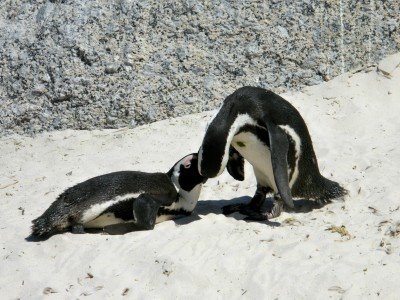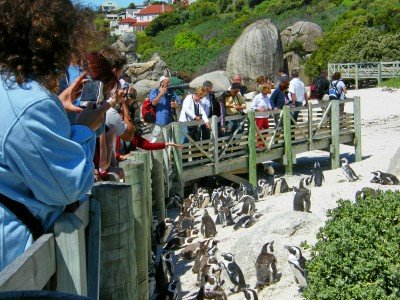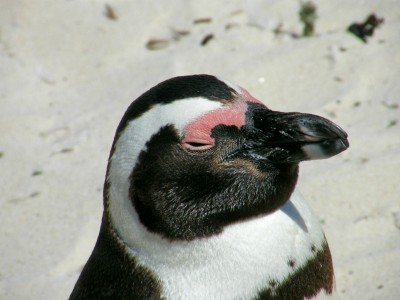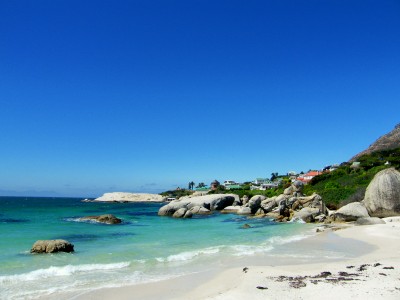Boulders Beach is a sheltered beach made up of inlets between granite boulders, from which the name originated. It is a popular tourist stop because of a colony of African Penguins which settled there in 1982.
Although set in the midst of a residential area, it is one of the few sites where this endangered bird can be observed at close range, wandering freely in a protected natural environment.
 From just two breeding pairs in 1982, the penguin colony has grown to about 3000 in recent years. This is partly due to the reduction in commercial pelagic trawling in False Bay, which has increased the supply of pilchards and anchovies, which form part of the penguins’ diet.
From just two breeding pairs in 1982, the penguin colony has grown to about 3000 in recent years. This is partly due to the reduction in commercial pelagic trawling in False Bay, which has increased the supply of pilchards and anchovies, which form part of the penguins’ diet.
Although the colony at boulders beach is the best known colony, its not the biggest. The biggest breeding colony of African Penguins (previously known as Jackass Penguins, although that name is now deemed “politically incorrect”) is found on St Croix Island in Algoa Bay right here by Port Elizabeth. A boardwalk takes visitors to within a few meters of the birds. On the day we were there last week the wind was blowing and most of the penguins were hiding or taking shelter. A big number of them where sheltering right next to the walkway which made viewing them up close possible.
A boardwalk takes visitors to within a few meters of the birds. On the day we were there last week the wind was blowing and most of the penguins were hiding or taking shelter. A big number of them where sheltering right next to the walkway which made viewing them up close possible. Here is an interesting story of an event that happened a couple of years ago involving African Penguins.
Here is an interesting story of an event that happened a couple of years ago involving African Penguins.
Disaster struck on June 23, 2000, when the iron ore tanker MV Treasure sank between Robben Island and Dassen Island (just north of Cape Town) oiling 19 000 adult penguins at the height of the best breeding season on record for this vulnerable species. The oiled birds were brought to an abandoned train repair warehouse in Cape Town to be cared for. An additional 19,500 un-oiled penguins were removed from Dassen Island and other areas before they became oiled, and were released about a thousand kilometres east of Cape Town, near Port Elizabeth. This gave workers enough time to clean up the oiled waters and shores before the birds could complete their long swim home (which took the penguins between 2 and 3 weeks). Some of the penguins were named and radio-tracked as they swam back to their breeding grounds. Tens of thousands of volunteers descended upon Cape Town to help with the rescue and rehabilitation process which took more than three months to complete. Although this was the largest animal rescue event in history, more than 91% of the penguins were successfully rehabilitated and released – an amazing feat that could not have been accomplished without such a tremendous international response – Wikipedia


Well this post sure threw me for a loop. I thought all penguins were in cold climates and I picture them on ice.. not sand. Blogging is so educational. Thanks for the penguin lesson 🙂
I’ve heard about these penguins, and I heard about the mishap with the iron ore tanker a few years ago. What an amazing story. Penguins remind me of people. I know this sounds silly, but why would Jackass Penguins be politically incorrect? Is it because of the very, very (!!!) bad movies made by that name?
I love these little guys, fantastic shots.
Lovely!. I never seen penguins in the wild